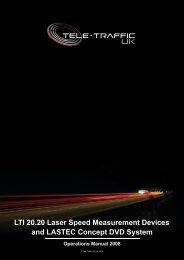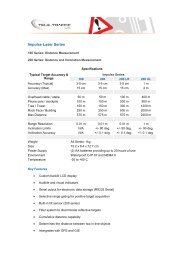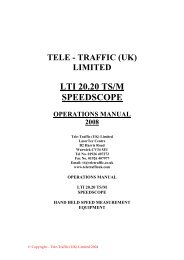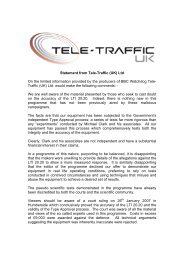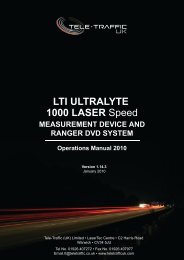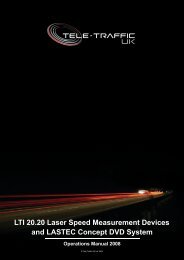LTI TRUCAM LASER MEASUREMENT DEVICE - Tele-Traffic
LTI TRUCAM LASER MEASUREMENT DEVICE - Tele-Traffic
LTI TRUCAM LASER MEASUREMENT DEVICE - Tele-Traffic
Create successful ePaper yourself
Turn your PDF publications into a flip-book with our unique Google optimized e-Paper software.
Adjusting Camera Settings<br />
The Camera’s default settings are set for optimum results in a typical situation. You may need to adjust<br />
some settings based upon your preference or current location.<br />
Depth of Field<br />
The depth of field (DOF) is a unit of measurement<br />
that represents the range of distances within an<br />
image where the focus is acceptably sharp. This is<br />
the distance in front of and beyond the subject that<br />
appears to be in focus. The DOF is determined by<br />
the subject distance, the lens focal length and the<br />
lens F-stop. On the TruCAM, you cannot change the<br />
distance and the lens focal length, so only the F-stop<br />
is variable. The TruCAM is able to adjust gain in<br />
accordance of the aperture. During a capture session,<br />
a larger f-number is better.<br />
The two images to the right have the same focus, but the f-number of Figure 40(A) is 2.8 and Figure<br />
40(B) is 16. In Figure 40(B), the DOF is much greater. In Figure 40(B) the fine branches of a small tree<br />
a sort distance in front of the lasers camera now become visible.<br />
Practical Note: At the time image Figure 40(B) was captured the light was very poor. To highlight<br />
the effect of Depth of Field the F16 f-stop had to be used. As with any type of camera if a high F-stop<br />
is employed and the light is insufficient the image takes on a dark graining effect as shown in this<br />
example. If your images are dark with graining readjust the F-stop to clear the effect.<br />
Iris<br />
Iris is an adjustable aperture used to control the amount of light coming through the lens. The more<br />
the iris is opened, the more light it lets in and the brighter the image will be. Aperture is the unit of<br />
measurement that defines the size of the opening in the lens that can be adjusted to control the<br />
amount of light that reaches the digital sensor. The size of the aperture is measured in F-stop. The Iris<br />
Adjustment Ring may be positioned on an F-stop or anywhere in between two F-stops.<br />
In any type of environment, maintain the biggest f-number possible.<br />
The smaller the f-number, the bigger the opening (more light).<br />
Typical value on cloudy or foggy day = 8 to 11.<br />
The bigger the f-number, the smaller the lens opening (less light).<br />
Typical value on sunny day = 11 to 16.<br />
Automatic Gain Control<br />
Automatic Gain Control (AGC) optimises picture quality at all times during the day. It increases the<br />
video signal at low light levels to make the picture brighter. If the majority of the image is dark, AGC<br />
will adjust the entire image to make it more easily viewable.<br />
This option is available during the Capture Mode. Tap or press the soft key to toggle<br />
AGC ON or OFF.<br />
If the toolbar button is not displayed, tap or press the soft key.<br />
ON: The icon is displayed at the top of the LCD Touch Screen and AGC electronically adjusts the<br />
camera to the proper light level.<br />
OFF: The icon is not displayed at the top of the LCD Touch Screen.<br />
AGC cannot compensate for all lighting conditions and typically must be used in conjunction with an<br />
adjustment of the lens iris.<br />
33<br />
Figure 40A Figure 40B<br />
© <strong>Tele</strong>-<strong>Traffic</strong> UK Ltd 2011



